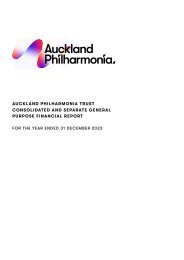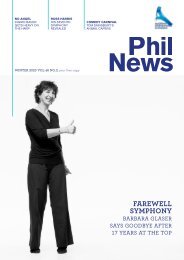APO Annual Report 2020
Create successful ePaper yourself
Turn your PDF publications into a flip-book with our unique Google optimized e-Paper software.
<strong>APO</strong> ANNUAL REPORT <strong>2020</strong><br />
AUCKLAND PHILHARMONIA TRUST<br />
CONSOLIDATED AND SEPARATE FINANCIAL STATEMENTS<br />
FOR THE YEAR ENDED 31 DECEMBER <strong>2020</strong><br />
Notes to the consolidated and separate financial statements<br />
4. SIGNIFICANT ACCOUNTING POLICIES (CONT'D)<br />
j) Employee benefits<br />
Liabilities for wages and salaries (including non-monetary benefits), annual leave and other benefits are recognised<br />
in surplus or deficit during the period in which the employee rendered the related services, and are generally<br />
expected to be settled wholly within 12 months of the reporting date. The liabilities for these short-term benefits<br />
are measured at the amounts expected to be paid when the liabilities are settled.<br />
k) Investment property<br />
Investment property is property held to earn rental income, but not for sale in the ordinary course of business or<br />
used in the production or supply of goods or services or for administrative purposes.<br />
i. Recognition and measurement<br />
Investment property is measured initially at cost. Cost includes expenditure that is directly attributable to the<br />
acquisition of the investment property. The cost of self-constructed investment property includes the cost of<br />
materials and direct labour, any other costs directly attributable to bringing the investment property includes the<br />
cost of materials and direct labour, any other costs directly to bringing the investment property to a working<br />
condition for their intended use.<br />
ii. Reclassifications<br />
When an investment property that was previously classified as property, plant and equipment is sold, any related<br />
amount included in the revaluation reserve is transferred to retained earnings.<br />
When the use of an investment property changes to owner occupied, such that it results in a reclassification to<br />
property, plant and equipment, the property's fair value at the date of re-classification becomes its cost for<br />
subsequent accounting.<br />
For a transfer from inventories to investment property, any differences between the fair value of the property at<br />
that date and its previous carrying amount is recognised in surplus or deficit.<br />
iii. Depreciation<br />
Depreciation is charged at rates calculated to allocate the cost or valuation of the investment property less any<br />
estimated residual value over its remaining useful life, on a diminishing value basis. Refer policy (e) on depreciation<br />
of Property, plant and equipment for depreciation charged over land and buildings.<br />
iv. Derecognition<br />
Investment properties are derecognised either when they have been disposed of or when the investment property<br />
is permanently withdrawn from use and no future economic benefit or service potential is expected from its<br />
disposal.<br />
Any gains and losses on the retirement or disposal of an investment property are recognised in surplus or deficit in<br />
the year of retirement or disposal.<br />
44<br />
17
















